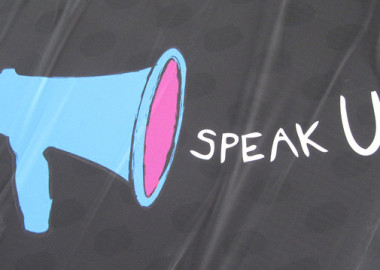 As a business leader, you’re called on to engage and inspire your team. You’re expected to persuade others of the power of your ideas. And you need to illustrate those ideas in a way people not only understand, but feel—and then can act on. For all of it, story works—in business, just as in life. Leadership storytelling centres on using the emotional heft of story to illustrate ideas and to truly connect with others. It’s about communicating more effectively, in a way that feels true to you.
As a business leader, you’re called on to engage and inspire your team. You’re expected to persuade others of the power of your ideas. And you need to illustrate those ideas in a way people not only understand, but feel—and then can act on. For all of it, story works—in business, just as in life. Leadership storytelling centres on using the emotional heft of story to illustrate ideas and to truly connect with others. It’s about communicating more effectively, in a way that feels true to you.
Me, I’m a business owner, a consultant, and a teacher. I don’t think of myself first as a storyteller, but I know that when I’m standing in front of a classroom or a boardroom, looking out at a collection of facial expressions that always seem, somehow, a mixture of impossibly keen, neutral, and possibly anticipating my failure, my desperate brain turns to story. And for good reason.
Here are a few reasons why leaders like you might consider adding storytelling to your toolbox, too.
Stories are memorable.
Nobody wants to be forgotten. Especially if you’ve gotten up the nerve to stand up in front of that group of students or investors to make a speech or presentation–and you just happen to be speaker #3 on a list of 7. AND you’ve got the after-lunch slot. Groan.
Here’s the good news: people more accurately and quickly remember all kinds of information when it’s first presented in the form of an example or story.
Stanford University professor Jennifer Aaker makes this point beautifully in her short film, Persuasion and the Power of Storytelling (embedded below)—by telling a story, of course. Take a moment to watch—it’s worthwhile (and you’ll remember it).
Aaker notes that when researchers asked a group of students to make a persuasive pitch to the other students, most did so with statistics. Only one in ten, she said, told a story. When asked ten minutes later to record everything remembered from the various presentations, only 5% of the students could recall any statistics. But 63% remembered the stories.
Can you relate? I’ll bet you can.
Story persuades (and fuels better presentations).
We’ve heard it before. Listening to a good story can change the activity in our brains, producing a neurochemical called oxytocin, which can promote trust and motivate voluntary cooperation.
Paul J. Zak, founding director of the Center for Neuroeconomics Studies, has put it this way: “These findings on the neurobiology of storytelling are relevant to business settings. For example, my experiments show that character-driven stories with emotional content result in a better understanding of the key points a speaker wishes to make and enable better recall of these points weeks later. In terms of making impact, this blows the standard PowerPoint presentation to bits.”
Says Zak:
I advise business people to begin every presentation with a compelling, human-scale story. Why should customers or a person on the street care about the project you are proposing? How does it change the world or improve lives? How will people feel when it is complete? These are the components that make information persuasive and memorable.
Story can create shorthand relationships.
I totally ignored Zak’s point, above, in a recent presentation I was delivering. Yep. I just plain forgot.
Our content strategy team was meeting with a client interested in streamlining their internal content operations: they wanted to avoid duplication, craft better content, and make more of the content they had. As a team, we’d done weeks of intensive work on this project. We’d interviewed dozens of people, examined existing workflows, drafted a detailed content strategy document, drawn up beautiful graphs and charts illustrating a new workflow, and I’d just stood there for 20 minutes explaining it all—to a few enthusiastic nods from some of the senior staff we’d already met with, but to a disturbing number of furrowed brows and uncomprehending expressions among those I hadn’t previously met with. Not good.
I paused, and my brain thankfully turned to story. Remembering Nancy Duarte’s ‘what is versus what could be’ structure (watch, above), I stepped away from the Powerpoint, and tried to fix things. I asked the group to remind me of their current situation. One person raised a hand.”Draft posts that sit in somebody’s inbox and never get approved,” he said firmly, adding: “it drives me completely mental.” “Annoying manual processes,” someone else said. More hands went up. “Great posts that never get promoted!” The group laughed. They complained. They commiserated. We wound up making a hefty list, populated by very real, detailed examples of frustration and wasted effort. Then I switched tacks. I asked them to imagine where they wanted to be. Again, they volunteered scenarios. “More than 200 page views!” someone volunteered. “Any positive comment on Facebook!” “To be able to find my own article on the website!” Yes, yes, and yes. They told—and more importantly felt together—the story of their own future state.
It was almost, for a few moments, like we’d been through it all together—simply because I’d listened for a few minutes and shared an experience like theirs.
I then told a story of a publishing company in a very similar situation a few years earlier, when I was in their shoes—when some irritating consultant came in and advised our company about what to do. I described the stops and starts we made as our teams tried to implement the seemingly impossible required changes. I told them about the four editors who quit along the way in frustration and defiance. About all the mistakes we made. And I told them how it had ultimately taken nearly three years and way too many failed experiments along the way to transform—but that we did transform, accomplishing many of the goals they’d dreamed about. I also made sure to add—realizing in the telling of my story that I just may have come across as that irritating consultant I’d described from my earlier days—that this was no quick fix, but that it would be worth it, and we’d be there to help along the way.
I’d taken about fifteen minutes away from the presentation to share their stories and to tell mine. Now in the room I saw relaxed shoulders, nods and smiles. The questions were about how the new workflow was different than that of the company I’d described. That clear picture had become our shared foundation of understanding. The people present had actually felt the resistance that the people in that publishing company felt. They felt the struggle. And they felt the hard-won victory, too. It was almost, for a few moments, like we’d been through it all together—simply because I’d listened for a few minutes and shared an experience like theirs. And that gave us shared ground to stand on.
Story hits ’em right in the feels.
We all like to think that we’re rational and in control. But are we? Emotions play an enormous role in every decision we make, every day, for better or for worse. And story taps directly into our emotions, moving us in a way that information alone can’t–much as I saw firsthand in that presentation I described. As Tony Robbins says:
Stories go far beyond simply relaying facts and data. Stories emotionalize information. They give color and depth to otherwise bland material, and they allow people to connect with the message in a deeper, more meaningful way. Those potential customers can then connect with your product, service and your entire business in a more profound way.
This, of course, applies directly to leadership. Whether you are speaking with someone one-on-one or to that crowd out there, you can make a profound emotional impact by telling the right story well. This doesn’t mean you need to leave your audience in tears (although there may be some instances where that helps); but rather that story can add the human touch and colour you need to make your audience feel the struggles or successes you’re describing.
Story bonds us. Literally.
Our brains interact with other brains, daily. Princeton neuroscientist Uri Hasson discovered in a study that examined social interaction that our brains actually ‘couple’ when conversing—it’s referred to as “neural coupling.” Hassen’s study revealed that “during successful communication the listener’s brain responses become similar to the speaker’s brain responses,” implying that “people understand each other by mirroring each other’s brain responses.”
This applies to conversation, and to story. Think about it. Since the storyteller and the listener demonstrate similar neural activity when a story is told, it’s possible to connect that listener viscerally to experiences or events that he or she hasn’t actually lived through—and yet feels profoundly. This is powerful stuff, as a leader: to be able to share successes, compelling your audience to feel them as powerfully as you; to be able to share crushing defeats, and have your listeners feel those with you. Story allows you to truly connect.
Leadership storytelling compels action.
In his excellent TED Talk on leadership storytelling, author and management consultant Steve Denning makes the point that negative stories, while useful for capturing attention, rarely work to inspire action. It’s positive stories, Denning says that make people feel hope for change and betterment, that make them take action and change behaviour.
When it comes to inspiring people to embrace some strange new change in behavior, storytelling isn’t just better than the other tools. It’s the only thing that works.
Your Takeaway as a Leader
Storytelling is an incredibly powerful leadership tool to improve communication, connection, and persuasion. But it’s not a cure-all.
In this interview, Paul Smith, who wrote the excellent book, Lead with a Story: A Guide to Crafting Business Narratives that Captivate, Convince, and Inspire, makes the point that storytelling shouldn’t–and can’t–be applied in every situation.
But he says when it works, it works better than nearly anything else. I share this opinion.
Storytelling isn’t always the right tool to help you manage things; but it’s exceptional at helping you lead people. ~Paul Smith, Author, Lead With Story
“For example,” Smith says, “if you’re trying to decide what your five-year strategy should be, what you need is a good strategist. Or if you’re trying to decide how much money to pay to acquire your biggest competitor, what you need is a good financial advisor. But once you’ve decided what your five-year strategy is going to be, and you need the 15,000 people that work at your company to line up behind it and deliver it, now you need a good story. Or once you’ve acquired your biggest competitor, and you need the 5,000 people that work there to stay, and not quit, now you need a good story.
In short, storytelling isn’t always the right tool to help you manage things; but it’s exceptional at helping you lead people.”
Got one of your own #leadershipstories to tell? Reach out on Twitter: @echostories





